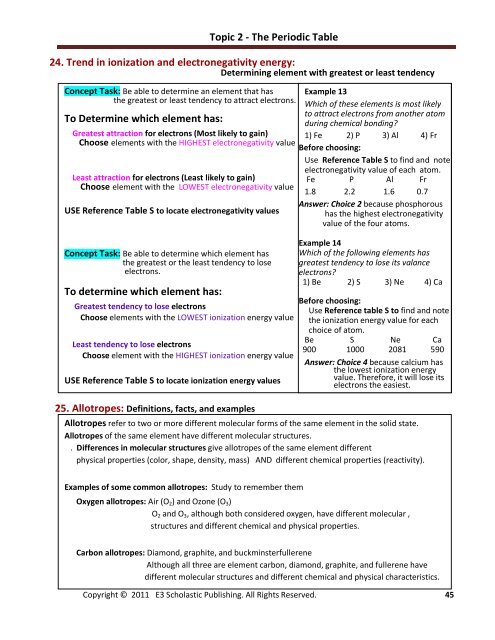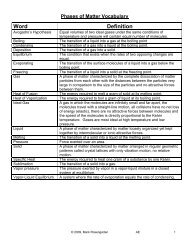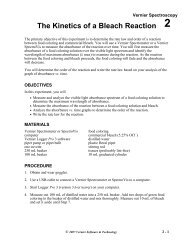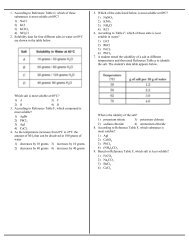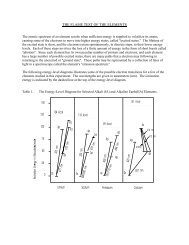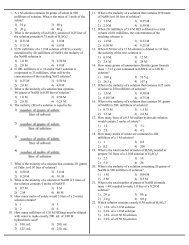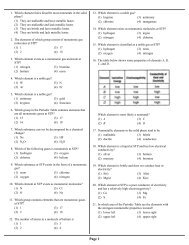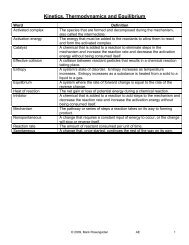Topic 1 - Matter and Energy - Revsworld
Topic 1 - Matter and Energy - Revsworld
Topic 1 - Matter and Energy - Revsworld
You also want an ePaper? Increase the reach of your titles
YUMPU automatically turns print PDFs into web optimized ePapers that Google loves.
Concept Task: Be able to determine an element that has<br />
the greatest or least tendency to attract electrons.<br />
To Determine which element has:<br />
Greatest attraction for electrons (Most likely to gain)<br />
Choose elements with the HIGHEST electronegativity value<br />
Least attraction for electrons (Least likely to gain)<br />
Choose element with the LOWEST electronegativity value<br />
USE Reference Table S to locate electronegativity values<br />
Concept Task: Be able to determine which element has<br />
the greatest or the least tendency to lose<br />
electrons.<br />
To determine which element has:<br />
25. Allotropes: Definitions, facts, <strong>and</strong> examples<br />
Allotropes refer to two or more different molecular forms of the same element in the solid state.<br />
Allotropes of the same element have different molecular structures.<br />
. Differences in molecular structures give allotropes of the same element different<br />
physical properties (color, shape, density, mass) AND different chemical properties (reactivity).<br />
.<br />
<strong>Topic</strong> 2 - The Periodic Table<br />
24. Trend in ionization <strong>and</strong> electronegativity energy:<br />
Determining element with greatest or least tendency<br />
Greatest tendency to lose electrons<br />
Choose elements with the LOWEST ionization energy value<br />
Least tendency to lose electrons<br />
Choose element with the HIGHEST ionization energy value<br />
USE Reference Table S to locate ionization energy values<br />
Example 13<br />
Which of these elements is most likely<br />
to attract electrons from another atom<br />
during chemical bonding?<br />
1) Fe 2) P 3) Al 4) Fr<br />
Before choosing:<br />
Use Reference Table S to find <strong>and</strong> note<br />
electronegativity value of each atom.<br />
Fe P Al Fr<br />
1.8 2.2 1.6 0.7<br />
Answer: Choice 2 because phosphorous<br />
has the highest electronegativity<br />
value of the four atoms.<br />
Example 14<br />
Which of the following elements has<br />
greatest tendency to lose its valance<br />
electrons?<br />
1) Be 2) S 3) Ne 4) Ca<br />
Before choosing:<br />
Use Reference table S to find <strong>and</strong> note<br />
the ionization energy value for each<br />
choice of atom.<br />
Be S Ne Ca<br />
900 1000 2081 590<br />
Answer: Choice 4 because calcium has<br />
the lowest ionization energy<br />
value. Therefore, it will lose its<br />
electrons the easiest.<br />
Examples of some common allotropes: Study to remember them<br />
Oxygen allotropes: Air (O 2 ) <strong>and</strong> Ozone (O 3 )<br />
O 2 <strong>and</strong> O 3 , although both considered oxygen, have different molecular ,<br />
structures <strong>and</strong> different chemical <strong>and</strong> physical properties.<br />
Carbon allotropes: Diamond, graphite, <strong>and</strong> buckminsterfullerene<br />
Although all three are element carbon, diamond, graphite, <strong>and</strong> fullerene have<br />
different molecular structures <strong>and</strong> different chemical <strong>and</strong> physical characteristics.<br />
Copyright © 2011 E3 Scholastic Publishing. All Rights Reserved. 45


